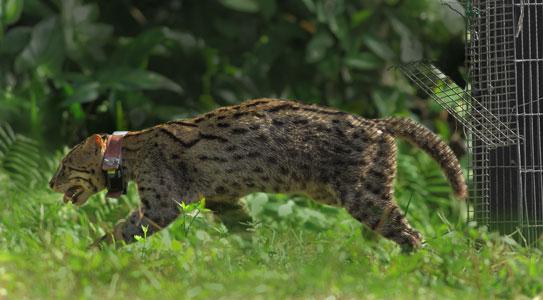Article featuring the project.
Anya Ratnayaka
The objective of this study is to assess the home ranges and ranging behaviours of fishing cats in urban wetland habitats, in order to understand their ecology, behaviour, and adaptations to human dominated landscapes. In collaboration with the Department of Wildlife Conservation, we will use the data obtained during the study to create an urban wetland management protocol to maintain these habitats in a sustainable manner.

Fishing cats (Prionailurus viverrinus) rely heavily on wetland habitats. In Sri Lanka they are most commonly seen inhabiting marshes and other wetlands found in and around Colombo and other major cities. However, as urban development continues to expand at a rapid pace, these wetland habitats are quickly being filled up despite the important ecological role that they play as natural sinks, drainages for flood water and ‘green areas’ for aesthetic purposes. Some marshes such as the Bellanwila-Attidiya Sanctuary and the Sri Jayawardenepura wetland have already been gazetted as protected areas. However, even with a protected status, these wetland habitats currently have insufficient management plans.
This species is a good focal species for the conservation management of these sanctuaries, since they are a habitat specialist and require marshy areas that have an adequate prey base. This is the very reason this species has been chosen for this project. They also qualify as a flagship species due to their charismatic value, but are fast earning a negative reputation due to their conflicts with the people living around the sanctuaries. Further, as the ecosystem’s top predator, they are likely to have relatively large home ranges and can therefore be an umbrella species.
During the course of the study period, this project will focus on capturing and collaring at least 3 different fishing cats, once every 3 months within urban marshlands and natural areas to compare their ecology and behaviour in natural and urban habitats. The data will provide insights into urban planning with “green set asides” for biodiversity, using the fishing cat as a focal species for planning and design.
Apart from capturing fishing cats in the wild, we will also collar some of the ‘rescued’ fishing cat kittens, that have been displayed in urban wetlands during monsoon seasons and usually brought in by people living in and around these areas. These cats are generally released back into urban wetlands after rehabilitation. We will track these animals and the information gained from therein will be useful for the release program as well as for providing insights into better urban fishing cat and habitat conservation programs.
As a small note, apart from fishing cats we also have confirmed reports of Rusty-spotted Cats (Prionailurus rubiginosus) in these wetlands.